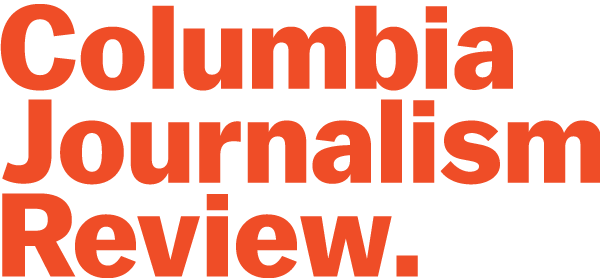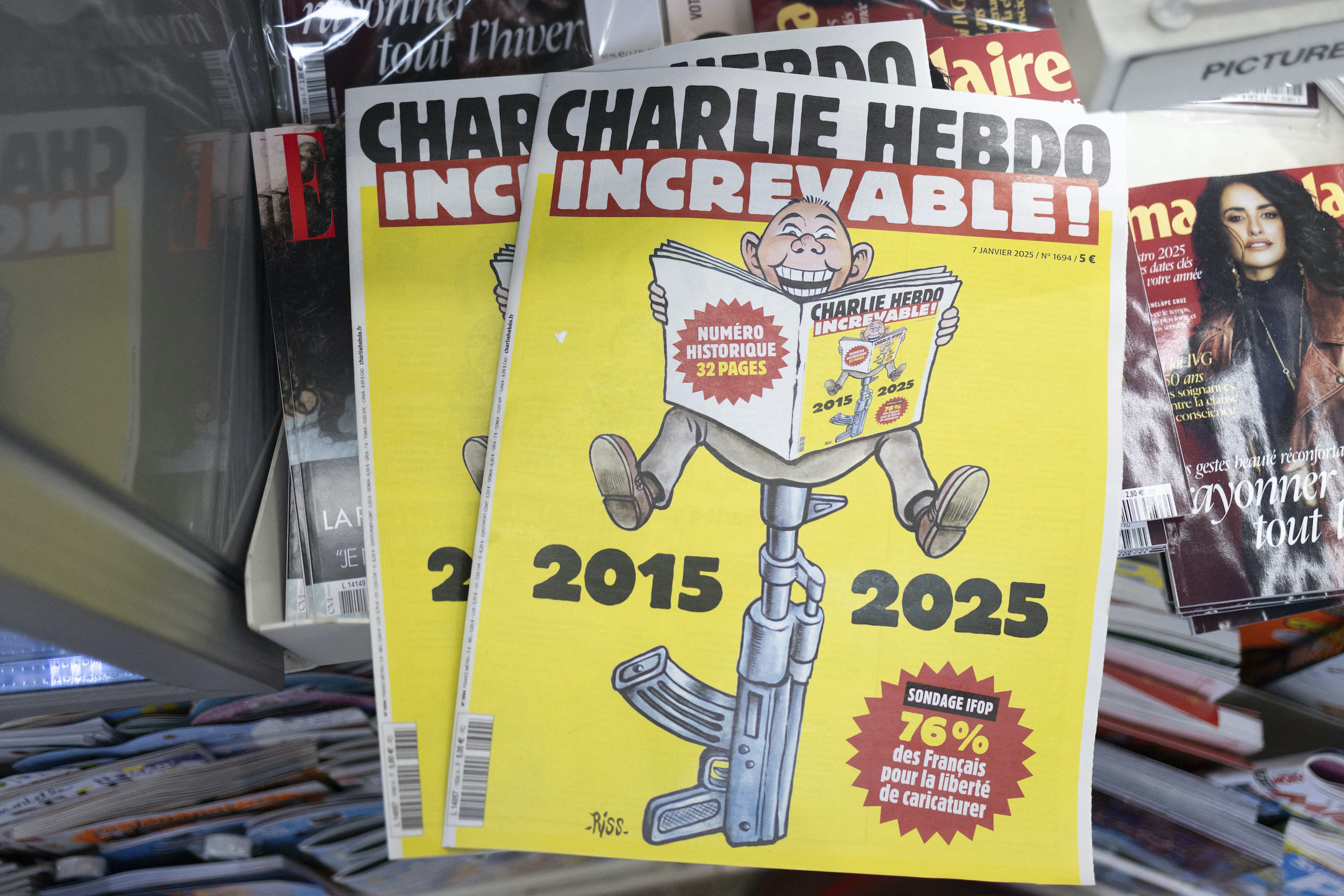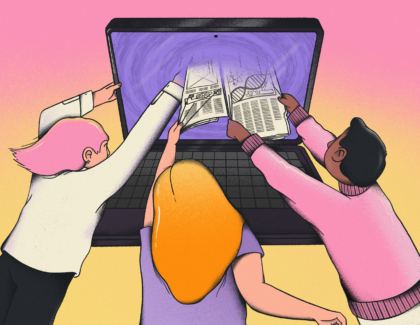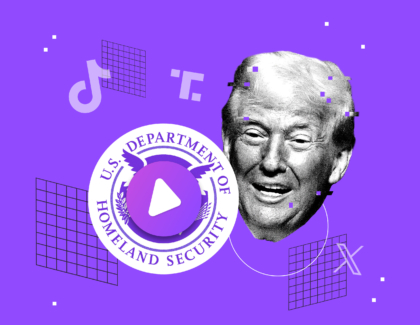Sign up for the daily CJR newsletter.
Nearly twenty years ago, in September 2005, Jyllands-Posten, a newspaper in Denmark, published cartoons that depicted and mocked the Prophet Muhammad, a practice that Muslims generally consider to be idolatrous. In the months that followed, the paper’s decision touched off a huge reaction across the Muslim world, ranging from diplomatic censure to peaceful protests and some acts of violence; meanwhile, several European newspapers themselves published drawings of Muhammad, including, in February 2006, the controversial French satirical magazine Charlie Hebdo, which reproduced the Jyllands-Posten cartoons alongside another, by its staffer Jean Cabu, that showed Muhammad cringing and saying, “It’s hard to be loved by jerks.” The following year, Georges Wolinski, another cartoonist at Charlie Hebdo, submitted a report to France’s culture ministry offering ideas on how to defend and promote satirical cartooning, including the proposed creation of a maison (or center) dedicated to the preservation of the practice.
Ten years ago today, in January 2015, the staff of Charlie Hebdo held their first editorial meeting of the year. They debated a new book, by the controversial author Michel Houellebecq, depicting an imagined Muslim president of France; “everyone was on top form and happy,” one journalist recalled. The staff heard what they thought were firecrackers in the street outside, then saw a man enter the office with a gun; initially, the journalist said, the staff suspected a practical joke, but it soon transpired that it wasn’t. Two terrorists affiliated with a branch of Al Qaeda had gained entry to the offices. In total, they killed twelve people, including a janitor and eight members of the editorial staff. Both Cabu and Wolinski were among the dead. The massacre sparked a manhunt and several terrifying days in France, during which an associated terrorist killed a police officer, then four Jewish people at a kosher grocery store in Paris. (All three attackers were eventually killed by police.)
The Charlie Hebdo massacre instantly inspired a wave of global shock and revulsion. Demonstrations and vigils quickly formed in the streets of various cities; meanwhile, the slogan “Je Suis Charlie,” imprinted in blocky white and gray letters on a black background, roared across social media as an expression of solidarity. I remember being badly shaken by the attack, which occurred while I was the editor of a student newspaper in London. We put a version of the “Charlie” slogan on our next front page, alongside a cartoon we commissioned that showed the blue tears of mourners and the red blood of the victims flowing together to form a French flag, with a white rose and a pen growing up in between.
This morning, similar notes of remembrance and defiance have been sounded, in France and beyond. Dignitaries including Emmanuel Macron, the president, gathered at the scene of the attack. On its front page, the left-leaning newspaper Le Monde reproduced a cartoon that also played on the motif of a bloodied French flag; accompanying the illustration was an editorial, headlined “France still in shock,” that likened the impact of the attacks of January 2015 to that of 9/11 in the US. (“In France, it wasn’t a symbol of financial power that was targeted, but a priceless, fundamental double heritage: freedom of expression and the right of French Jews to live in peace in their country.”) In interviews, surviving Charlie Hebdo staffers have spoken of the importance of persisting with their craft. The magazine itself published a special anniversary issue, in which it declared that “the desire to laugh will never go away,” displayed four pages of cartoons mocking deities, and featured a poll showing strong ongoing support in France for the freedom to caricature. The cover depicts a grinning man reading the issue while seated on the barrel of an assault rifle.
And yet, in many ways, the legacy of the massacre is more complicated than this throughline of loud defiance in the name of press freedom might suggest. Threats to the magazine—and the practice of satirical cartooning more generally—have not gone away, with press freedom in decline and Islamist-inspired terrorism once again a major story in the West. At the same time, thorny debates around the limits of satire and religious tolerance have reasserted themselves in a context of bitter political polarization and ever-rising xenophobia and Islamophobia—going so far as to challenge the meaning of the “Je Suis Charlie” slogan itself. Nor has the story of the massacre itself ended, with questions around how it ought to be memorialized yet to be fully resolved.
The massacre at Charlie Hebdo provided a direct impetus for initiatives that have advanced the cause of press freedom. Laurent Richard—a journalist who worked at the time for Premières Lignes, a documentary company that had offices close to Charlie Hebdo’s—was among the first outsiders on the scene after the attack. What he saw that day would, among other things, spur him to start Forbidden Stories, a collaborative global journalism organization that specializes in continuing the work of murdered or otherwise threatened reporters around the world. “This happened in my environment. Not abroad, not on the front line. This time it was in the middle of Paris,” Richard told me when Forbidden Stories launched in 2017, referring to the Charlie Hebdo massacre. “That was a kind of turning point” that made him “much more aware about the fragility of the free press.”
In other ways, though, the aftermath and collective memory of the massacre have been messier. As early as October 2015, the BBC asked whether its legacy had “gone sour” amid reported disagreements inside Charlie Hebdo as to how bold to be editorially going forward and how to spend an influx of cash that had come the magazine’s way following the attack, all amid crushing trauma and fears of further violence. Such fears were not hypothetical. In September 2020, as a trial began for alleged accomplices in the 2015 massacre, Charlie Hebdo republished the Muhammad cartoons, describing them as essential evidence, sparking another round of global uproar. Later that month, the magazine’s human resources director had to be evacuated from her home for her safety; then, a Pakistani man angered by the cartoons stabbed two people outside Charlie Hebdo’s old offices, apparently not realizing that the magazine had moved to an undisclosed new location following the 2015 attack. The victims both worked for Premières Lignes, Richard’s old company. (“It was just a signal that the terrorism is still there and the profession of journalism is very at risk—more than ever, actually,” Richard told me at the time.) Fortunately, both survived their injuries.
Around the same time, Samuel Paty, a schoolteacher in the Paris suburbs, displayed Muhammad cartoons as part of a lesson on freedom of expression and the meaning of the “Je Suis Charlie” slogan. (He reportedly offered students who might be offended the opportunity not to look at the cartoons.) Soon after, Paty was decapitated while walking down the street—part of another wider spasm of Islamist terror in France. Macron made remarks defending the publication of blasphemous cartoons, sparking a furious diplomatic reckoning with various majority-Muslim countries—in particular Turkey, which, among other things, threatened legal and diplomatic action against Charlie Hebdo over a scurrilous cartoon depicting Recep Tayyip Erdoğan, its president.
All of this touched off a fresh debate, within France but also beyond its borders, over the appropriateness of Muhammad cartoons and a litany of related issues. In one extraordinary episode (that enraged some French journalists), Macron gave an interview to Ben Smith, then the media columnist at the New York Times, in which he blasted various foreign outlets for coverage that he saw as legitimizing Islamist violence by centering the context of anti-Muslim bigotry. (I wrote about that spat at the time.) Around the same time, the Times published a different story noting that the “Je Suis Charlie” slogan had become contentious, separating people “on either side of France’s major fault lines, including freedom of speech, secularism, race, national identity and, of course, Islam.” Joachim Roncin, the graphic designer who created the slogan, said that it had become so divisive that he wished it would cease to exist. Other critics suggested that Charlie Hebdo and others have begun to conflate Islamism, the ideology, with Islam, the religion, and that the slogan had been co-opted by the right.
The dissension has continued—and continued to be messy. In 2023, a minister in Macron’s government sparked controversy when she gave an interview to a Sunday paper that had just undergone a hard-right takeover, and justified it by casting herself as a defender of press freedom in the tradition of Cabu, the late Charlie cartoonist; in response, Charlie Hebdo slapped back, with a top editor pointing out that Cabu ceaselessly opposed the French far right. Indeed, figures associated with the magazine have continued to situate it broadly on the political left, suggesting that any progressive critics have abandoned it, not vice versa. This week, various articles marking the anniversary of the massacre have suggested that the left has betrayed its legacy, or that modern pieties have placed ever more stifling limits around the freedom to offend. Le Monde’s editorial this morning argued that the unanimity of the “Je Suis Charlie” moment feels distant now, and has given way to a sad “relativism,” especially among younger people. And yet Charlie Hebdo’s current director told Le Monde that he doesn’t see a censorial new generation abandoning the magazine, even as he has bemoaned elsewhere that the social “margin of tolerance” around its work has narrowed.
As I see it, debates of this sort are best seen not through the prism of a decade-long arc toward spinelessness, but as cyclical: satirical cartoons have always provoked discussion and recriminations linked to questions of taste, decency, and censorship—including, in the case of Muhammad cartoons, in the immediate aftermath of the 2015 massacre. (As Roncin, the designer, noted to the Times in 2020, the “Je Suis Charlie” slogan was contested from the outset; as editor of my student paper at the time, I remember receiving criticism both for publishing the slogan and for deciding not to republish the Muhammad cartoons.) The director of Charlie Hebdo noted to Le Monde that the type of cartooning the magazine does has always been marginal—hence the need for it in the first place. Its circulation has declined since 2015. But it remains higher than it was beforehand.
What is not in doubt is that the overall environment for the world’s press has deteriorated since 2015—both in terms of its financial health and its freedom from oppression—and that these dual trends have been bad for the practice of press cartooning as a whole, exacerbating a much longer-term decline for the genre, in France but also in the US and elsewhere. As one media historian noted to Le Monde recently, the threat of violent reprisal has likely contributed to this decline—and may continue to do so at a moment when the threat of terrorist attacks is back in the headlines in Western countries in a major way. (In an interview today to mark the anniversary, France’s interior minister warned that the risk of attacks is particularly elevated right now, claiming that the country foiled nine last year.) Such fears have also, it would appear, complicated efforts to memorialize the Charlie Hebdo massacre as an isolated event—efforts that remain unfinished even ten years on.
For all the talk of its symbolic legacy, the facts of the Charlie Hebdo story and the subsequent, related violence have not yet finished unspooling. Various accomplices of the magazine’s assailants were convicted following the 2020 trial; another accomplice, who allegedly trained one of the attackers, was only convicted in October of last year. Shortly before Christmas, a court convicted eight people of involvement in the beheading of Paty, the teacher, in 2020, on charges including direct assistance and the dissemination of online hate against him. (The man who beheaded Paty was killed by police at the time.) Just yesterday, a trial began in the case of the stabbings outside Charlie’s former offices in 2020. Of course, the survivors of all those attacks have lived with the consequences ever since. During the trial of the alleged accomplices in the 2015 attack, Simon Fieschi, a Charlie Hebdo staffer who was seriously wounded that day, said that he is living “in post-trauma, and will be all my life.” In October, he was found dead in a Paris hotel. The cause was unclear. He was forty years old.
In 2020, around the fifth anniversary of the massacre, President Macron pledged that he would work to set up a center for press cartoons and satirical drawings—realizing the vision that Wolinski, the Charlie Hebdo journalist, had proposed before he was killed in the attack; the space would be used for exhibitions but also to train cartoonists, and perhaps even to offer refuge to those fleeing authoritarian regimes. A venue in Paris was chosen and funds were allocated—but then, last year, the project appeared to stall, as the French government, increasingly beset by political chaos, went silent. One source suggested to Le Monde that some French officials were blocking the project out of concern that the site would be a ripe target for another attack. Nor was it clear whether the center would display cartoons of Muhammad—many advocates of the center insisted that it would be absurd not to, given their centrality to the history of the venture, but others feared the risks. “We are realizing that, ten years later, France is no longer Charlie at all,” Wolinski’s daughter told Le Monde in October. “I’m not even sure that if the project was abandoned it would be controversial.”
In November, Rachida Dati, France’s current culture minister, finally confirmed that the center would go ahead, though it is now not scheduled to open until 2027, several years behind the initial ambition. Over the weekend, Dati reiterated the commitment in a post on X. “Press cartooning is an elaborate and precious form of democratic impertinence that we must defend,” she wrote. The proposed center “will be a place of remembrance in memory of those who fell in the service of freedom of expression.… It is up to us not to forget them.”
Other notable stories:
- Breaking this morning: Mark Zuckerberg, the CEO of Meta, announced that the company would put an end to the third-party fact-checking operation that had been tasked with curbing the spread of misinformation across its platforms, and replace it with a system of user-submitted corrections and notes similar to the one that Elon Musk has instituted on X since acquiring that platform; Zuckerberg said that the current system had “reached a point where it’s just too many mistakes and too much censorship,” adding that “recent elections also feel like a cultural tipping point towards once again prioritizing speech.” The news was the latest in a series of moves that appear to be positioning Meta closer to the incoming Trump administration, including the addition to its board yesterday of Dana White, the UFC executive and Trump ally.
- For CJR, Norman Pearlstine, the former editor of the LA Times, argues that billionaires—including Patrick Soon-Shiong, that paper’s owner—have proved poor stewards of media companies and that the press must now fight for democracy. “The truth may not matter to the wealthy owners and CEOs who are treating Trump as much like a pope as a president,” Pearlstine writes. “But journalists must redouble our efforts to expose every conflict of interest, every lie, and every threat to democracy.” Also for CJR, Robert Mackey explored the divergent cases of two young content creators who filmed inside the Capitol on January 6, 2021; both claim to be journalists, but only one has subsequently been prosecuted by the US government.
- According to Jennifer Jacobs, of CBS, the incoming administration is planning to “revamp” the White House media operation, including by moving the press secretary out of their normal office. In other news about jobs in DC, Trump tapped Tammy Bruce, (yet another) longtime contributor on Fox News, to serve as the spokesperson in his State Department—even though, as Politico’s Daniel Lippman points out, she has in the past mocked her likely new boss: Trump’s selection for secretary of state, Marco Rubio. And the recent exodus of prominent reporting talent from the Washington Post continued: Leigh Ann Caldwell is off to Puck to be chief Washington correspondent.
- Journalists at The Athletic—the sports news site that was acquired by the Times in 2022, and has become more integrated with the paper’s news offering since it dissolved its own sports desk—signaled their intention to unionize with the same guild that represents other staffers in the Times newsroom. “We do journalism for the New York Times,” The Athletic’s Katie Strang said, “and we believe we should have the same rights and protections as the Times Guild folks.” The Times has yet to comment on the journalists’ request; the Post’s Ben Strauss has more details.
- And a new study in the journal Nature, undertaken by researchers at the University of Pennsylvania’s Annenberg Public Policy Center, examined whether media coverage of the consequences of conflicts abroad, including civilian casualties, influences public support for US intervention. The study found “that media coverage of civilian casualties increases public support for US involvement in conflicts by evoking empathy for the victims—but only when those victims are from allied countries.”
Has America ever needed a media defender more than now? Help us by joining CJR today.







